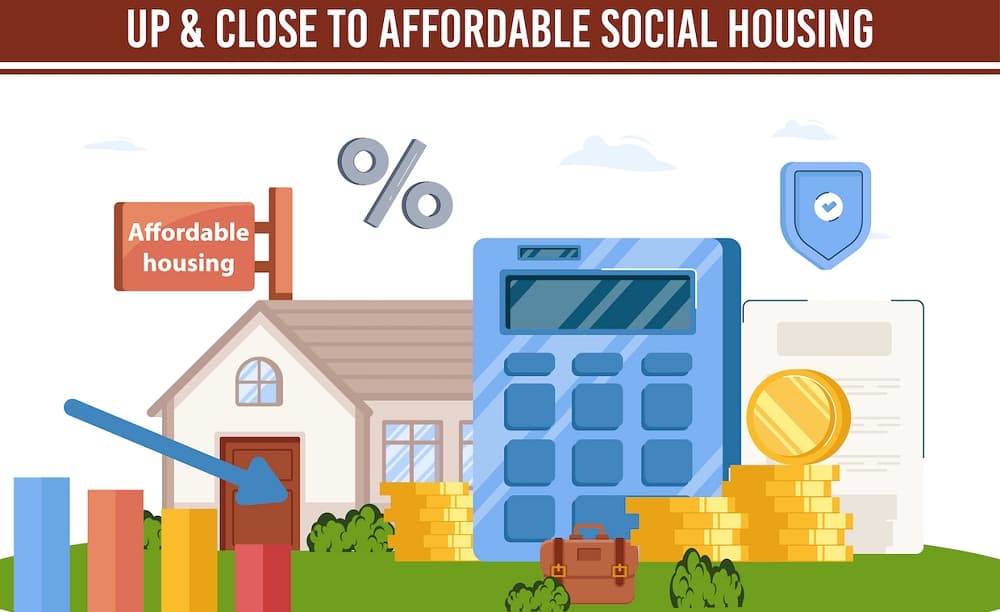
Indian architecture has always valued cultural diversity and community, which is reflected in its social housing schemes. As urbanization and global innovation have changed housing trends, Indian designers are focusing on low-cost and sustainable social housing programs to meet the demand.
But how do we create these holistic yet social community settings? Social housing must employ sustainable building methods and materials to achieve the goal of inexpensive housing. India is one nation that boasts some of the most successful social housing projects. Here, in this article, we have compiled a list of 10 affordable housing initiatives in India that are altering the way we think about large-scale social housing programs.
10 Innovative Low-cost Housing in India
01. Aranya Community Housing

Location: Indore, Madhya Pradesh
Master architect BV Doshi was fully aware of the ever-extending family dynamics of Indian households and proposed a low-rise, high-density master plan for the project. The 85 hectares’ moderate slope determined the direction of infrastructure serving the 6,500 plots. Niches and quiet corners maintain intimacy, yet courtyards and wide terraces enable life’s richness to overflow into these efficiently designed hierarchical social spaces.
The overall design was focused on instilling a sense of belonging, encouraging inhabitants’ participation, and allowing people to express their ambitions, connections, and social dynamics.
Trivia: Aranya Low-cost housing is one of the first initiatives to integrate the idea of cost-effective planning with humane design principles.
02. The Stanwood Residency

Location: Halol, Gujrat
The Stanwood Residence is a space architectural project with stilt flats and two-bedroom houses that are distinguished by bright colours and modern style. The row homes have sloping roof terraces, while the apartment block prioritises ventilation and natural light. It is the goal of the initiative to provide everyone with access to high-quality homes.
In this row house design, roof terraces with sloping walls that appear to have been scooped out of the façade provide striking visuals. In contrast to the natural landscape, straight lines and angles dictate the spatial layout. With modest balconies and abundant openings, the apartment building ensures unrestricted ventilation and natural light.
03. Tara Housing

Location: Delhi, India
Master Architect Charles Correa firmly believed that high-rise buildings disconnected their inhabitants from society. This principle led him to design the Tara cooperative, which has 160 units in 4-storeyed modules peppered with interesting open spaces. All units have views of the centre courtyard, which is more of a community area. Open stairs connect the centre Courtyard to each residential unit.
Strategic planning based on climatic factors makes this housing economical as well as a social initiative. For instance, the space between the dwellings generated reciprocal shade while also reducing the rigidity of the long building facade, making the construction more human-scale.
04. Housing for Mahouts and their Elephants

Location: Jaipur, Rajasthan
This social housing catered to a specific community, i.e the Mahouts and their elephants. Rajasthan’s Public Works Department commissioned RMA Architects to create this affordable community housing.
The site layout used a clustering method to create shared common spaces at various hierarchies in order to foster a sense of community among the residents. Courtyards and terraces enhance the otherwise minimal budgeted space of 40 sqm for this primarily affordable housing complex.
Trivia: The design strategy entailed rebuilding the topography, which was degraded by sand quarrying. This also included constructing water bodies for rainfall gathering and livestock upkeep in Rajasthan’s desert environment.
05. CIDCO Housing in Navi Mumbai

Location: Navi Mumbai, Maharashtra
Raj Rewal’s firm was hired to build 1,000 social housing units for low-income groups as an experiment in urban planning and architecture in New Mumbai. The 1,048 flats required under the scheme were a mix of smaller one-to-two-room units and bigger two-bedroom units that were to be sold separately. Based on pedestrian language, the design built a dwelling ensemble of various clusters and confined areas that emerged from and melded into the landscape. Intimate courtyards and shaded pedestrian paths play a significant social function in the low-rise, high-density chains created by joining the blocks.
06. Sublime Ordinaries Housing Project

Location: Vasind, Maharashtra
The Mumbai Chawls’ single-loaded corridor style acts as a catalyst for creating a sense of community in this social housing project. Sublime Ordinaries, designed by DCOOP Architects, is located northeast of Mumbai, housing 54 households of staff working in an industrial facility. The four apartments on each floor are connected by a shared hallway, which includes a staircase at one end. These features have been given a tinge of contemporary aesthetics, making them more interesting and harmonious.
Trivia: The architects included traditional elements to sculpt the social spaces of the project. Apartments on the bottom level are accessed separately by their modest semi-private area or Otla.
07. Sheikh Sarai Housing Complex

Location: South Delhi
Sheikh Sarai Housing Complex in South Delhi, designed by architect Raj Rewal for low-rise, high-density living, integrates unit design with pedestrian networks and community spaces inspired by Haveli, with clear boundaries between automotive and pedestrian streets to promote pedestrian traffic. A transition from private areas to public squares of various sizes with shaded routes running through them served as the basis for the connection between the individual and the community.
Trivia: Based on the Haveli typology, Sheikh Sarai’s design creates optimal assemblages of community dwellings by enhancing, refining, and perfecting traditional urban spatial layouts.
08. Chengalchoola Housing

Location: Trivandrum, Kerala
Chengalchoola Housing’s design deviates from the area’s typical repetition-based massing of social housing schemes. This housing was a slum redevelopment project undertaken by Laurie Baker. This project was intended to be a bridge between affordable high-rises and relatively expensive higher-density low-rises. Baker included ample open spaces, thus creating a sense of community within the clusters.
Trivia: Baker breaks away from typical slum rehabilitation projects by using a thoughtful palette of locally sourced labour and raw materials.
09. Atira Staff Housing

Location: Ahmedabad, Gujrat
BV Doshi’s Atira staff housing is a social housing project that prioritizes sustainability and local resources, utilizing low-cost natural materials and vaults for air circulation. Each residence has a garden and veranda for summer sleeping. The design creates microsocial spaces and informal gathering areas, resembling a small hamlet.
10. Incremental Housing in Belapur

Location: Navi Mumbai, Maharashtra
Belapur Housing by Charles Correa uses a hierarchical clustering mechanism to create separate plots for future extension, with seven houses clustered around a small courtyard. The community features five different types of homes and has a charming village vibe with whitewashed cottages and Mangalore tile roofs.
The housing complex features five different types of homes, ranging from a private room with a bathroom to a two-story apartment. Adjacent homes share a toilet wall to simplify plumbing services.
5 Things to Remember while Designing Social Housing
01. Site Context and Climatic Factors
A housing scheme can be affordable if we take advantage of the site’s features and climatic factors. If we make use of wind and solar power, we won’t need artificial lighting or ventilation systems. In addition, most housing projects, such as Aranya and CIDCO Housing, used the natural slope of the terrain rather than constructing against it.
02. Circulation and Communal Spaces
Human interaction and the effective design of public spaces are key components of social housing schemes. But how do we implement elaborate community spaces and public infrastructure in a low-budget housing scheme? It is critical to incorporate indoor and outdoor areas in projects, including social yet affordable housing. In the Indian context, our hallways and verandas act as semi-private spaces where people socialize.
03. Multifunctional Design Principles
The essence of social housing designs is to create free-flowing spaces with few distinctions between functions. Multifunctional design approaches optimize space requirements right from the micro level, i.e unit design, to macro design elements like community spaces. For instance, most social housing plans eliminate the typical apartment layout and shift to studio apartment modules or shared spaces.
04. Accessibility
Unique accessibility features should be implemented in order to produce an organized yet socially interactive housing scheme. By reserving some driveways solely for automobile movement, it is possible to ensure optimal site circulation and the safety of the occupants while constructing. Furthermore, low-cost housing projects should prioritize pedestrian access to the dwelling site as well as other potential points of interest.
05. Security
One of the most common criticisms levelled against modern social housing projects is that they are not safe enough, primarily due to all the shared facilities. A passive approach to this problem would be to clearly differentiate between public and private spaces, with unambiguous ownership of visibly shared spaces. This fosters sentiments of belongingness among the tenants and makes them active contributors to the space’s maintenance.
5 Government Schemes that Aid in Social Housing Projects
01. Pradhan Mantri Awas Yojana (PMAY)
This is India’s largest social housing program, which was launched in 2015. Its goal is to offer affordable homes for everyone by 2022. PMAY gives eligible individuals financial help to build a pucca home with essential facilities.
02. Rajiv Awas Yojana (RAY)
RAY was started in 2013 with the goal of making India slum-free by 2022. The project provided states and union territories with financial aid for slum remediation and the construction of affordable homes for the urban poor.
03. Jawaharlal Nehru National Urban Renewal Mission (JNNURM)
Launched in 2005, JNNURM aimed to improve urban infrastructure and provide basic services to the urban poor. The scheme provided financial assistance to states and cities for the construction of affordable housing as well as for the improvement of roads, water supply, and sanitation.
04. Housing for All (HFA)
HFA founded in 2015, seeks to offer affordable housing to everyone by 2022. The plan gives federal funding to states and union territories to provide affordable housing for the urban poor and middle class.
05. Pradhan Mantri Gramin Awaas Yojana (PMGAY)
PMGAY, which was launched in 2016, aims to give the underprivileged in rural areas access to inexpensive homes. The plan offers financial support to eligible individuals for the construction of a pucca home with basic facilities.
Witness how these Affordable Housing Projects impact India’s Future!
Most of us make do in low-income homes built by real estate developers by investing a significant amount of money. But these projects are testaments to the fact that architects are addressing issues related to social engagement, isolation, and affordability in urban high-rise housing through socially engaged housing programs that combine environmental and traditional approaches.
However, if you are looking for an affordable house, you should conduct thorough market research before making a purchase!
FAQs
01. What is a Housing Scheme?
Housing scheme is an initiative that offers low-cost homes for people to buy or rent, frequently supported by the local council or another organization.
02. Name some of the major Affordable Housing Schemes in India.
Some major affordable housing schemes in India are Pradhan Mantri Awas Yojana (PMAY), Rajiv Awas Yojana (RAY), Jawaharlal Nehru National, Urban Renewal Mission (JNNURM), Housing for All Scheme, Affordable Housing in Partnership Scheme (AHP) and Credit-Linked Subsidy Scheme (CLSS).
03. Is Affordable Housing Synonymous with Social Housing?
Social housing and affordable housing are two distinct concepts. Affordable housing is available to a greater variety of income brackets than social housing.
Image Courtesy: Image 02, Image 03, Image 04, Image 05, Image 06, Image 07, Image 08, Image 09, Image 10, Image 11
Author Bio
Saili Sawantt – She is an Architect and Interior Designer by profession. Writing is what she treats as her passion. She has worked as an Architectural Writer, Editor, and Journalist for various design as well as digital portals, both national and international. Formerly she has also worked with Godrej Properties Limited (GPL) Design Studio, Mumbai, due to her keen interested in learning about Sustainability and Green buildings. Apart from this, she runs her blog ‘The Reader’s Express’ and is a practicing Architect & Interior Designer.






























